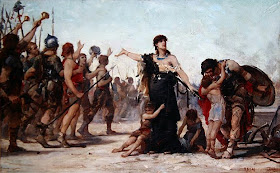An allegory is a figurative of representation of something abstract. Allegories became very popular in Renaissance and Baroque painting. Normally virtues, feelings or moods like Justice, Fidelity or Melancholy were represented by young women. Later with the discovery of the world these women were also used to symbolize the new continents. Europa was just known, now she was accompanied by the new invented Asia, America and Africa.

Europe Supported By Africa and America (1796). A typical 19th century illustration by William Blake (1757–1827).
Allegories as national symbols became popular not before the rising nationalism as a reaction on the French Revolution and the Napoleonic Wars.

Germania and Italia (1811-28). This peaceful allegory is by the German Romantic painter Johann Friedrich Overbeck (1789-1869) one of the founders of the Nazarene movement. Both people, the Germans and the Italians, were suppressed and far away from forming nations. Without nations, nationalists from many kingdoms were supporting each other.

But this harmony passed by in some decades. Here Germania (1849) by the German painter Christian Köhler (1809-1861) is called to arms by Justice. And she’s not only reaching for the sword, but also for the imperial crown.
Hardly surprising that with the beginning of the First World War the once so peaceful Germania has changed to an aggressive Valkyrie with armor, shield and sword and the crown on her head.

Germania (1914) by Friedrich August von Kaulbach (1850-1920).
There are a lot more examples from all European nations. Interesting and a little sad is how these once so peaceful figures were transformed into something so aggressive and hateful, they were mobilized.
 Millais shows here a member of that famous German mercenary corps that fought in British service against Napoleon. The young soldier parts from his lover before the battle of Waterloo. He is characterized by his black uniform and the prominent skull and crossbones on his hat. But I think these signs are serving also to indicate his almost certain fate, because the Brunswickers suffered terrible losses at Waterloo.
Millais shows here a member of that famous German mercenary corps that fought in British service against Napoleon. The young soldier parts from his lover before the battle of Waterloo. He is characterized by his black uniform and the prominent skull and crossbones on his hat. But I think these signs are serving also to indicate his almost certain fate, because the Brunswickers suffered terrible losses at Waterloo.










